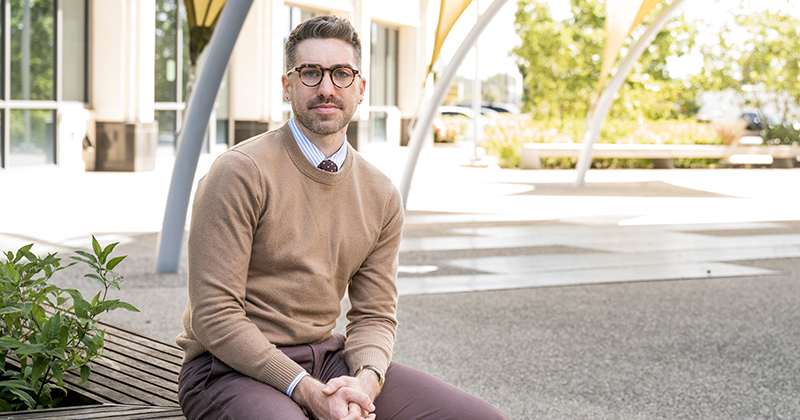


Uncovering pandemic inequities
Photo by Kathy F. Atkinson | Illustration by Jeffrey C. Chase October 02, 2024
UD epidemiology researcher finds inequities in COVID testing access, variant impact
More than four years after the COVID-19 pandemic caused the world to come to a standstill, lessons in pandemic response are still being learned. What we know: the global pandemic disproportionately affected racial and ethnic minority groups across the U.S., with Black and Hispanic individuals being three to four times more likely to die from COVID compared to white individuals.
New Assistant Professor of Epidemiology Daniel Harris, who joined the University of Delaware College of Health Sciences (CHS) this semester, took a deep dive into rarely obtained COVID-19 testing data. Harris led a team of investigators that included Walgreens and primary investigator Vincent Mor, professor of health services, policy and practice at Brown University, on a $1.9 million National Institute on Aging grant to examine the impacts of the COVID-19 pandemic on population health.
Harris and co-authors assessed 18 million COVID tests for racial and ethnic disparities in testing access and used whole genome sequencing to identify differences in novel variants of concern. Their research was recently published in the journal Frontiers in Public Health.
The cross-sectional study of free COVID tests from May 2021 through February 2022 found that non-white individuals were more likely to test positive for COVID-19.
“Racial and ethnic differences in COVID-19 positivity can be attributed to several factors, many of which are rooted or stem from systemic racism,” said Harris. “Racial differences in housing, density, job type, accessibility of healthcare services, and medical trust and mistrust contribute to COVID-19 inequities.”
He also attributed the finding to social risk exposure and community-level factors.
“Communities with larger populations of Black and Hispanic individuals show greater transmission, which increases one’s absolute risk of infection at the individual level,” Harris said.
The study’s authors did not measure whether individuals seeking testing were vaccinated against COVID-19.

Harris and coauthors also used genome sequencing on a subset of positive tests to explore differences in who was more likely to test positive for novel variants of concern like alpha, delta, and omicron. They found the omicron variant was more prevalent in racial and ethnic minority groups during its emergence, especially in urban settings.
“When members of marginalized communities get infected with novel variants of a virus, they bear the brunt of any potential differences in morbidity and mortality that result from the virus changing over time,” said Harris. “If a new variant is more severe or transmissible, they are the first to experience it.”
Walgreens and other pharmacies served as key players during the pandemic response to increase access to testing among vulnerable populations. That showed in the test results.
“The proportion of tests that were done roughly matched U.S. demographic statistics among Black, white, and Hispanic people, which gives us insight that those programs successfully accessed those populations.”
However, there’s a caveat.
“If non-white people experienced a greater disease burden, we expected to see them overrepresented in the testing data,” said Harris. “If that population is more likely to get sick, we should see more of them getting tested. A lack of representation implies continued inequities in testing access and use.”
Harris hopes to see more academic-private partnerships like this in the interest of public health.
“Leveraging health administrative databases that collect data in real-time is useful to public health surveillance and should be more widely accessible,” he said. “But accessing these data is expensive, and privacy barriers are also in play.”
However, research like this demonstrates that these types of analyses are possible.
“These data tell us important things about population health, and these mechanisms can be built into future pandemic response,” he said. “U.S. data infrastructure needs a massive overhaul; there are a lot of gaps, and that’s something we haven’t fully learned as a public health community, and it hurts our response to pandemics.”
Contact Us
Have a UDaily story idea?
Contact us at ocm@udel.edu
Members of the press
Contact us at 302-831-NEWS or visit the Media Relations website

